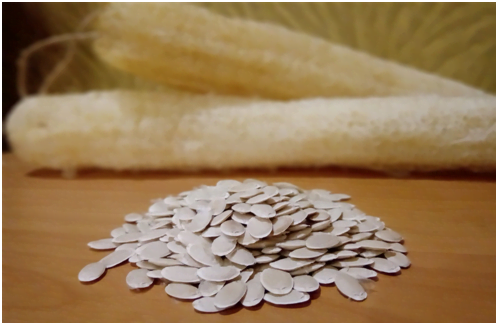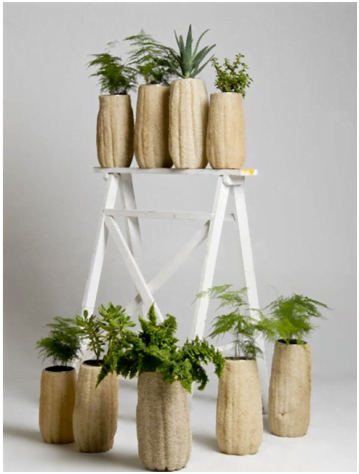Luffa is a vegetable of the pumpkin family which resembles a large cucumber or zucchini. Luffa is grown mainly for the production of natural dishcloths and sponges, and it is not yet widely known in cooking, despite a number of beneficial properties for health. The plant is considered to originate in Northwest India, where it appeared in the 13th century. Gradually, they began to grow it in the countries of Europe and Asia.
Vladimir Zhdanov, the founder of the family farm Family Loofa (Ukraine, Kherson region), spoke about the three main stages of the production and sale of luffa, its prospects and marketing during the webinar “Successful stories of niche cultures”.
The event was organized by the Ukrainian Horticultural Business Development Project. ì
As Vladimir Zhdanov notes, in 2018 he sowed luffa in the aisles of grapes. The choice of such a crop was not accidental – the farmer did not fully understand how luffa would grow, but he knew that the plant needed support. For this purpose, he chose grapes on which the luffa vine then grew.
“Out of 50 seeds that were planted then, we got about 30 plants. From 20 of these we harvested fruits,” notes the founder of the family farm Family Loofa, stressing that today his farm grows this crop on an area of 0.3 hectares.

According to Vladimir Zhdanov, there are three main stages in the cultivation of luffa: the cultivation itself, harvesting and packaging, marketing and sale.
“Growing luffa can be compared to the production of cucumbers. At the same time, the climate in Ukraine is quite suitable for growing luffa, especially the southern regions of the country. A trellis or a net is needed, because it is a liana-like plant and if it does not twine properly, it is very difficult to get fruits of the proper quality.
Specialists have previously tried growing the crop in field. However, they did not manage to get the proper volume and quality of the crop. The fact is that during the ripening period, luffa seems to tighten and take on an oblong shape – for this, a trellis is needed,” the farmer explains the features of the cultivation technology.
As to the selection of varieties, Vladimir Zhdanov says there are about 50 of them. The most suitable for growing in Ukraine is the cylindrical luffa. It is most convenient for the further production of dishcloths and sponges.

Note that there are also sharp-ribbed varieties of luffa. They are used for growing young, unripe fruit eaten as cucumbers, in soups and curries.
Leaves, shoots, buds and flowers of sharp-ribbed luffa are also eaten. The leaves of the plant are rich in carotene: its content is about 1.5 times higher than that of carrots or bell peppers. Leaves contain 11 mg/100 g of iron, 95 mg/100 g of vitamin C, and up to 5% of protein.


In Japan, cosmetics are made from the juice of the luffa stem, in particular, high-quality lipstick.
The founder of Family Loofa also notes that luffa vine grows up to 5 meters in height. “However, in our farm we allow it to grow up to 2.5 meters – in this case, the care of the plant, in particular, of its garter, is much easier. In addition, harvesting is greatly simplified in this way.
As for the use of plant protection products in the cultivation of luffa, we try not to interfere with the natural process of crop growth as much as possible, and therefore we do not use chemicals,” notes Vladimir Zhdanov.
Luffa harvesting begins after the fruits are fully ripe, which their brown color indicates. Another characteristic feature of the maturity of luffa is the weight of the fruit – it is about 200 grams, which is 10 times less than at the stage of ripening. Moreover, the whole process of harvesting is done manually.
“After harvesting it needs to be cleaned – this is a very slow process. After cleaning, luffa turns into a washcloth. The next stage is packing by size. We sort luffa in 30×40 and 40×50 cm sizes, which we then sell as washcloths. In addition, we produce special dishwashing sponges. The price of one washcloth is 98 UAH, and a sponge – 25 UAH. We also sell plant seeds at 360 UAH/300 pcs,” the founder of FamilyLoofa says about the features of the business.
Plant seeds are widely sold on online trading platforms in Ukraine. Their price depends on the type of plant and the producer of the seed – from 4 UAH to 45 UAH for 5 pcs.

Luffa is also widely offered on the Russian market, where it is grown mainly in the southern regions. At the same time, the price of a natural purified culture with a size of 30×40 cm, which can be used as a washcloth, is 70 RUB/piece. A scrubber made of one-piece luffa with handles is sold at 90 RUB/piece. The cost of seed material on Russian online trading platforms is about 17 RUB for a package of 5 grains.
In Uzbekistan, where the plant can be grown throughout the country, luffa sponges are sold at 1860 UZS/piece. A 20 cm long cylindrical washcloth made from local luffa is sold at 8304 UZS/piece.
As to promoting their products, Vladimir Zhdanov notes that Family Loofa started with pages in social networks, Facebook and Instagram. “The main buyer of luffa is a person who is interested in natural products. There are a lot of such people in social networks. Later, we also created our own website FamilyLoofa.com, where the entire line of our products is presented today” sums up Vladimir Zhdanov.
The use of the site materials is free if there is a direct and open for search engines hyperlink to a specific publication of the East-Fruit.com website.




